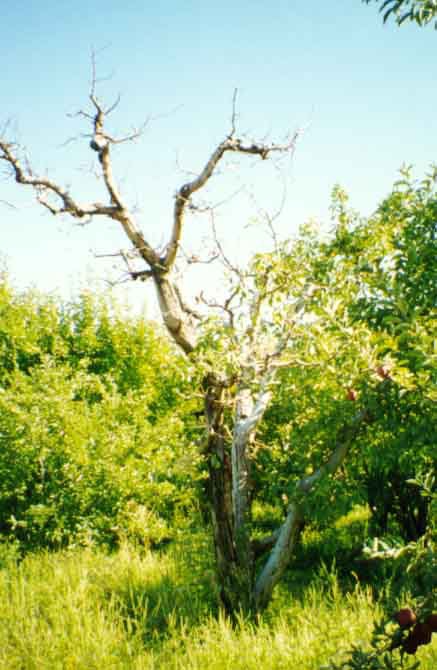
35 year old apple trees don't look so great.
I got together with my farm operator, Pat Sams, and we decided on a plan to make the farm productive. While my father liked to grow several types of trees to round out the crops, modern farming requires a different approach.
Cherries are a problem tree. They can sicken and die easily from viruses and you only get a good crop about every 5 years because rain usually cracks them before harvest. If you can afford to wait for that good crop every 5 years they can produce a very good income. We decided to stay away from cherries because we had a small block and were having trouble keeping the trees alive and well.
Prune trees are very vigorous and survive frosts well. The problem with them is that prices on the fresh market are not always that great. We already had 4 acres of early prunes planted and we decided to not go any further with this crop.
We could have also considered pears, but they are mostly a processor fruit and go into cans instead of the fresh market. The Milton-Freewater area doesn't have many pears planted and we ruled them out mainly for that reason. You will find a lot of pears in the Hood River and Wenatchee areas.
Other than pears, apples are the other main orchard crop that can make you money. A lot had been happening in the apple market from the time my father was farming. We had plenty of old apple trees, such as the one pictured above, but they were older varieties that didn't color well and brought poor prices at market. There were two basic ways we could go with apples: high density planting of a new variety or medium density planting of a more traditional variety. You can also plant low density like my father did, but you need to wait too many years to get into production and start making money. The new dwarf trees are planted high density and are optimized to start producing apples in quantity much sooner.
The new variety high density orchards can cost up to $150,000 to plant 10 acres. This was quickly ruled out because I didn't have that amount of money to spend. Instead we picked a more traditional Red Scarlet Spur apple and planted it at medium density. This came out to about 3000 trees per 10 acres. These apples are a form of red delecious that get a very solid red and also are ready for market early in the season. Both of these factors help when you want to get the best price for your crop. We planted 1000 trees in 1992 and 2000 more in 1993.
While I was at it, I also did something my father never would have done. I installed a sprinkler system. He had always used ditch irrigation and the existing 20 acres used it. The new apple block would use sprinklers. Not only do they use less water, but they also don't wash as much soil away. You can plant a grass crop under the trees which makes tending them much easier. Water is getting to be a scarce resource for farmers, so I was pleased to do something that would reduce my requirements for it.